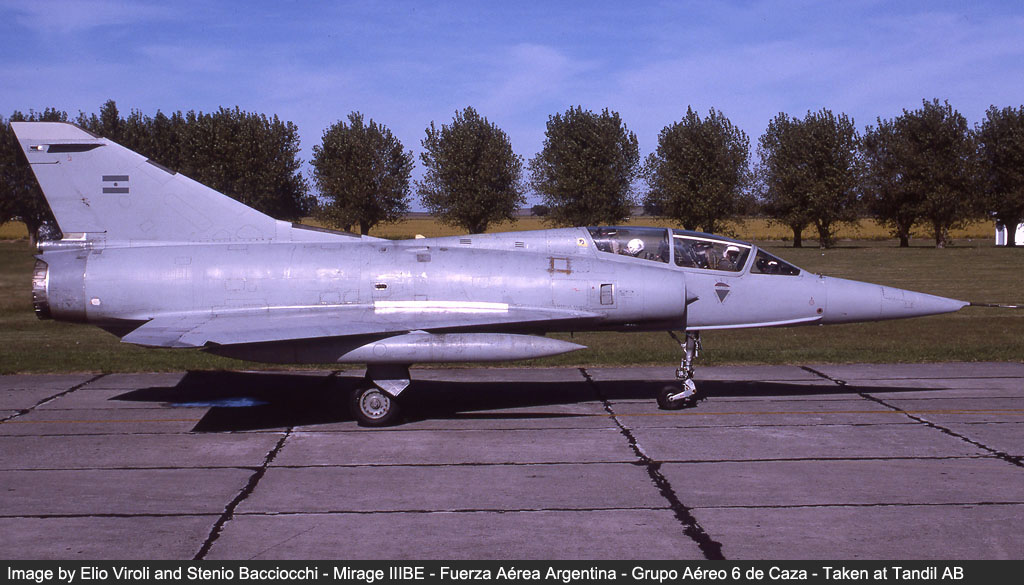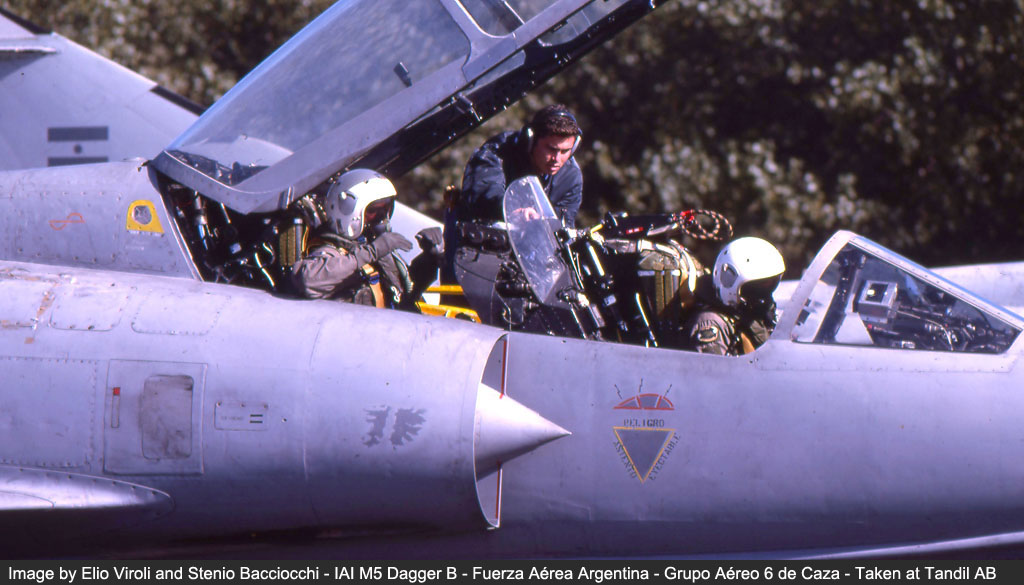 |
| All’inizio del millennio per vedere ancora in piena efficienza il Dassault Mirage III ed il suo derivato Mirage V, si doveva attraversare l’Atlantico ed andare in Argentina, nella base aerea di Tandil, a circa 300 km da Buenos Aires. Il Dassault Mirage III infatti, una macchina dal pilotaggio difficile ma dalla semplice manutenzione , volava ancora nella Fuerza Aérea Argentina (FAA) in ben sei versioni diverse, fra cui il Mirage IIIEP/BE, il Mirage VP, i derivati Finger e Dagger A/B di produzione israeliana IAI (Israel Aircraft Industries) A quell’epoca, tutti i superstiti del velivolo francese in forza alla FAA erano stati concentrati sulla base aerea di Tandil ed inquadrati nella VI Brigata Aerea - Grupo 6 de Caza, allo scopo di facilitarne la manutenzione e meglio organizzare l’addestramento degli equipaggi; la città a sud-est di Buenos Aires era così diventata una sorta di “Mirage City”, e divenne meta dei molti “fans” del caccia supersonico transalpino. Nel ripercorrere la lunga vita operativa dell’aviogetto Dassault nella FAA si deve iniziare nel 1972 quando 17 Mirage EA, un DA e due biposto BE vennero consegnati dalla ditta transalpina via mare; l’Argentina si era rivolta alla Francia come fornitore di armi per aggirare l’embargo imposto dagli USA a causa delle violazioni dei diritti umani che avvenivano in quel periodo nel paese sudamericano. Seguì nel 1978 un ordine per 26 IAI Dagger, il Mirage V prodotto da Israele; questa versione venne scelta per la maggiore autonomia ed il costo più accessibile. Vennero acquistati anche alcuni Dagger B, la versione biposto da addestramento. I Dagger subirono le perdite maggiori nella guerra delle isole Malvines contro il Regno Unito; agli inizi degli anni 80, nel conflitto dell’Atlantico del sud, i Dagger operarono come bombardieri anti-nave a bassa quota, con bombe da 250 chili, il che li rese particolarmente vulnerabili. Le perdite vennero rimpiazzate da 10 Mirage VP di provenienza peruviana in base ad un accordo di reciproco aiuto in campo militare. Negli anni novanta alcuni Dagger vennero portati allo stadio di Finger I con l’aggiornamento dell’avionica eseguito dalla israeliana IAI; in pratica i velivoli vennero equiparati alla versione Kfir C2 allora in servizio nella Forza Aerea dello stato ebraico. In seguito furono eseguiti altri aggiornamenti dell’avionica con la sostituzione delle componenti di produzione inglese, non più reperibili a causa dell’embargo, ed il risultato furono le versioni II e III. Nella primavera del 2000 quando visitammo l’base aerea di Tandil, la VI Brigata Aerea - Grupo 6 de Caza era composta da tre gruppi di volo: - Escuadròn Dagger - Il Escuadròn con Mirage IIIEA - Escuadròn Mirage V-A Mara |
 |
 |
 |
 |
 |
 |
 |
| Nella base era operativa anche una Sezione di soccorso e collegamento dotata di elicotteri Hughes 369HM, e aerei da collegamento Cessna Ce182 e AeroCommander RC500U, la Squadriglia era dipendente dalla VI Brigata Aerea. In quei giorni il Gruppo da addestramento era il più impegnato, perché erano appena arrivati alla VI Brigata Aerea alcuni piloti dalle scuole. I nuovi piloti provenivano dalla BA di Mendoza ed erano abilitati sul velivolo nazionale IA-63 Pampa, un “tranquillo” aviogetto da addestramento, a Tandil si trovavano invece alle prese con un velivolo caratterizzato dalla alta velocità d’atterraggio, unita alla ridotta visibilità che l’ala a delta comportava nella delicata fase di touch down. Iniziava quindi un complesso iter addestrativo che comprendeva oltre duecento ore di volo per diventare combat ready sul Mirage. Il neo pilota poteva però contare sull’alta competenza dei meccanici e degli istruttori che dopo tanti anni conoscevano perfettamente le macchine della Dassault e IAI, avendo ottimizzato l’impiego tattico dei caccia sui vari teatri operativi. Vedemmo in azione tutte le versioni del Mirage presenti. I caccia francesi ed israeliani avevano da non molto adottato una livrea a bassa visibilità molto “spinta”, applicata in modo maniacale in seguito alla traumatizzante esperienza della guerra delle Malvines, il grigio esaltava sì la linea dei Mirage ma a distanza ne rendeva difficile l’identificazione. Solo la lettura dei codici presenti in luoghi nascosti come l’interno dell’alloggiamento del carrello rendeva possibile appunto una corretta identificazione del velivolo. Visitammo anche la Squadriglia di Collegamento dove invece potemmo ammirare la vistosa coccarda azzurra/bianca e la bandiera con il sole “di maggio”. Nonostante già allora si parlasse della prossima radiazione dei caccia, gli ultimi esemplari di Mirage V sono stati messi definitivamente a terra solo alla fine del 2015 dopo ben 43 anni di onorato servizio nella FAA. Tuttora non è stato ancora scelto un effettivo valido sostituto, con le stesse prestazioni del brillante aviogetto della Dassault. |
 |
 |
 |
 |
|
Foto e testo di Elio Viroli e Stenio Bacciocchi Marzo 2000 |
|
English translation At the beginning of the millennium to see the Dassault Mirage III and its derivative Mirage V still in full efficiency, one had to cross the Atlantic and go to Argentina, in the air base of Tandil, about 300 km from Buenos Aires. |
|
Images and text by Elio Viroli and Stenio Bacciocchi March 2000 |
- Dettagli
- Prodotto da - Produced by Ciarini Giorgio
- Categoria: Contributors
- Visite - Visits: 1608